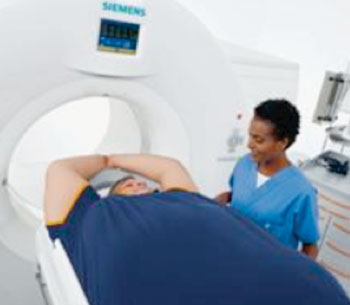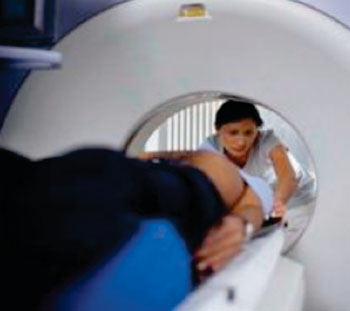Changing the Shape of CT Scanners in Response to Patient’s Expanding Waistlines
|
By MedImaging International staff writers Posted on 30 Jul 2014 |

Image: Changing CT scanners shape in response to patient waistlines. The CT imaging systems of today have up to 300 kg table weight allowance, 2 x 120 kW power, and an 80-cm bore (Photo courtesy of Siemens Healthcare).

Image: Older CT imaging systems had a 160 kg table weight allowance, 50 kw power, and a 70-cm bore (Photo courtesy of Siemens Healthcare).
As computed tomography (CT) imaging systems continue to grow in size, weight capacity and ability to adapt for the growing waistline of patient population is essential.
A recent evaluation, performed by Siemens Healthcare (Erlangen, Germany), of the historic and current statistics of CT imaging systems, has revealed a substantial increase in the design and capacity of computed tomography (CT) scanners provided to the United Kingdom’s NHS [National Health Service] and private hospitals over the past 15 years to accommodate the rise in obesity. This is comparable to recent figures published by Public Health England citing that 64% of people in the United Kingdom are now overweight or obese.
When an individual labeled as “obese” is referred to hospital for a scan, key considerations for clinicians include if the system will hold the person’s weight, if they can fit in the bore, and if there is enough power to penetrate the patient. The internal assessment, looking at a range of CT scanners over the past 20 years, has revealed that the weight allowance of imaging tables has increased by 88%. Furthermore, X-ray generator power, which contributes to scanners providing a good quality image in spite the patient’s size, has risen by 380%, the bore size, where the patient lies, has increased by a total of 10 cm.
“The number of bariatric patients being referred for CT scans has more than doubled in the last 25 years and this is predicted to continue rising,” states Russell Lodge, CT business manager at Siemens Healthcare. “We have witnessed a growing need and demand for obesity provision from hospital imaging departments across the country to ensure patients of all sizes can gain access to the treatment they need. It is essential that manufacturers respond from a design and innovation perspective to ensure that systems hold more weight, include a bigger bore and penetrate larger body mass.”
Being able to hold a person’s weight without causing damage to the scanner or risking injury to the patient is an increasingly important consideration for clinicians. Table weight allowances have nearly doubled from 160 kg in earlier scanners on the market approximately 10 years ago up to the availability of 300 kg allowances in current systems.
The X-ray generator power rating of a CT scanner is a significant factor in ensuring good image quality; therefore if there is not enough power when it comes to larger patients, a diagnostic image may not be captured. Power has increased substantially from around 50 kW 10 years ago, with the most advanced CT scanners now up to 2 x 120 kW, making it suitable for rapid volume coverage with obese patients.
In earlier generation diagnostic systems, the bore, where the patient enters the imaging system, would typically be 70 cm. Recently, this has expanded up to 80 cm. This is good news in response to a rising waist size in United Kingdom adults, which sees an average of 40% of adults with a raised waistline in 2012 compared to an average of 24% in 1993.
The older CT imaging systems had a 160 kg table weight allowance, 50 kW power capability, and a 70-cm bore. The CT imaging systems of today have up to 300 kg table weight allowance, 2 x 120 kW power, and an 80-cm bore.
Related Links:
Siemens Healthcare
A recent evaluation, performed by Siemens Healthcare (Erlangen, Germany), of the historic and current statistics of CT imaging systems, has revealed a substantial increase in the design and capacity of computed tomography (CT) scanners provided to the United Kingdom’s NHS [National Health Service] and private hospitals over the past 15 years to accommodate the rise in obesity. This is comparable to recent figures published by Public Health England citing that 64% of people in the United Kingdom are now overweight or obese.
When an individual labeled as “obese” is referred to hospital for a scan, key considerations for clinicians include if the system will hold the person’s weight, if they can fit in the bore, and if there is enough power to penetrate the patient. The internal assessment, looking at a range of CT scanners over the past 20 years, has revealed that the weight allowance of imaging tables has increased by 88%. Furthermore, X-ray generator power, which contributes to scanners providing a good quality image in spite the patient’s size, has risen by 380%, the bore size, where the patient lies, has increased by a total of 10 cm.
“The number of bariatric patients being referred for CT scans has more than doubled in the last 25 years and this is predicted to continue rising,” states Russell Lodge, CT business manager at Siemens Healthcare. “We have witnessed a growing need and demand for obesity provision from hospital imaging departments across the country to ensure patients of all sizes can gain access to the treatment they need. It is essential that manufacturers respond from a design and innovation perspective to ensure that systems hold more weight, include a bigger bore and penetrate larger body mass.”
Being able to hold a person’s weight without causing damage to the scanner or risking injury to the patient is an increasingly important consideration for clinicians. Table weight allowances have nearly doubled from 160 kg in earlier scanners on the market approximately 10 years ago up to the availability of 300 kg allowances in current systems.
The X-ray generator power rating of a CT scanner is a significant factor in ensuring good image quality; therefore if there is not enough power when it comes to larger patients, a diagnostic image may not be captured. Power has increased substantially from around 50 kW 10 years ago, with the most advanced CT scanners now up to 2 x 120 kW, making it suitable for rapid volume coverage with obese patients.
In earlier generation diagnostic systems, the bore, where the patient enters the imaging system, would typically be 70 cm. Recently, this has expanded up to 80 cm. This is good news in response to a rising waist size in United Kingdom adults, which sees an average of 40% of adults with a raised waistline in 2012 compared to an average of 24% in 1993.
The older CT imaging systems had a 160 kg table weight allowance, 50 kW power capability, and a 70-cm bore. The CT imaging systems of today have up to 300 kg table weight allowance, 2 x 120 kW power, and an 80-cm bore.
Related Links:
Siemens Healthcare
Latest Radiography News
- World's Largest Class Single Crystal Diamond Radiation Detector Opens New Possibilities for Diagnostic Imaging
- AI-Powered Imaging Technique Shows Promise in Evaluating Patients for PCI
- Higher Chest X-Ray Usage Catches Lung Cancer Earlier and Improves Survival
- AI-Powered Mammograms Predict Cardiovascular Risk
- Generative AI Model Significantly Reduces Chest X-Ray Reading Time
- AI-Powered Mammography Screening Boosts Cancer Detection in Single-Reader Settings
- Photon Counting Detectors Promise Fast Color X-Ray Images
- AI Can Flag Mammograms for Supplemental MRI
- 3D CT Imaging from Single X-Ray Projection Reduces Radiation Exposure
- AI Method Accurately Predicts Breast Cancer Risk by Analyzing Multiple Mammograms
- Printable Organic X-Ray Sensors Could Transform Treatment for Cancer Patients
- Highly Sensitive, Foldable Detector to Make X-Rays Safer
- Novel Breast Cancer Screening Technology Could Offer Superior Alternative to Mammogram
- Artificial Intelligence Accurately Predicts Breast Cancer Years Before Diagnosis
- AI-Powered Chest X-Ray Detects Pulmonary Nodules Three Years Before Lung Cancer Symptoms
- AI Model Identifies Vertebral Compression Fractures in Chest Radiographs
Channels
MRI
view channel
AI Tool Tracks Effectiveness of Multiple Sclerosis Treatments Using Brain MRI Scans
Multiple sclerosis (MS) is a condition in which the immune system attacks the brain and spinal cord, leading to impairments in movement, sensation, and cognition. Magnetic Resonance Imaging (MRI) markers... Read more
Ultra-Powerful MRI Scans Enable Life-Changing Surgery in Treatment-Resistant Epileptic Patients
Approximately 360,000 individuals in the UK suffer from focal epilepsy, a condition in which seizures spread from one part of the brain. Around a third of these patients experience persistent seizures... Read more
AI-Powered MRI Technology Improves Parkinson’s Diagnoses
Current research shows that the accuracy of diagnosing Parkinson’s disease typically ranges from 55% to 78% within the first five years of assessment. This is partly due to the similarities shared by Parkinson’s... Read more
Biparametric MRI Combined with AI Enhances Detection of Clinically Significant Prostate Cancer
Artificial intelligence (AI) technologies are transforming the way medical images are analyzed, offering unprecedented capabilities in quantitatively extracting features that go beyond traditional visual... Read moreUltrasound
view channel.jpeg)
AI-Powered Lung Ultrasound Outperforms Human Experts in Tuberculosis Diagnosis
Despite global declines in tuberculosis (TB) rates in previous years, the incidence of TB rose by 4.6% from 2020 to 2023. Early screening and rapid diagnosis are essential elements of the World Health... Read more
AI Identifies Heart Valve Disease from Common Imaging Test
Tricuspid regurgitation is a condition where the heart's tricuspid valve does not close completely during contraction, leading to backward blood flow, which can result in heart failure. A new artificial... Read moreNuclear Medicine
view channel
Novel Radiolabeled Antibody Improves Diagnosis and Treatment of Solid Tumors
Interleukin-13 receptor α-2 (IL13Rα2) is a cell surface receptor commonly found in solid tumors such as glioblastoma, melanoma, and breast cancer. It is minimally expressed in normal tissues, making it... Read more
Novel PET Imaging Approach Offers Never-Before-Seen View of Neuroinflammation
COX-2, an enzyme that plays a key role in brain inflammation, can be significantly upregulated by inflammatory stimuli and neuroexcitation. Researchers suggest that COX-2 density in the brain could serve... Read moreGeneral/Advanced Imaging
view channel
AI-Powered Imaging System Improves Lung Cancer Diagnosis
Given the need to detect lung cancer at earlier stages, there is an increasing need for a definitive diagnostic pathway for patients with suspicious pulmonary nodules. However, obtaining tissue samples... Read more
AI Model Significantly Enhances Low-Dose CT Capabilities
Lung cancer remains one of the most challenging diseases, making early diagnosis vital for effective treatment. Fortunately, advancements in artificial intelligence (AI) are revolutionizing lung cancer... Read moreImaging IT
view channel
New Google Cloud Medical Imaging Suite Makes Imaging Healthcare Data More Accessible
Medical imaging is a critical tool used to diagnose patients, and there are billions of medical images scanned globally each year. Imaging data accounts for about 90% of all healthcare data1 and, until... Read more
Global AI in Medical Diagnostics Market to Be Driven by Demand for Image Recognition in Radiology
The global artificial intelligence (AI) in medical diagnostics market is expanding with early disease detection being one of its key applications and image recognition becoming a compelling consumer proposition... Read moreIndustry News
view channel
GE HealthCare and NVIDIA Collaboration to Reimagine Diagnostic Imaging
GE HealthCare (Chicago, IL, USA) has entered into a collaboration with NVIDIA (Santa Clara, CA, USA), expanding the existing relationship between the two companies to focus on pioneering innovation in... Read more
Patient-Specific 3D-Printed Phantoms Transform CT Imaging
New research has highlighted how anatomically precise, patient-specific 3D-printed phantoms are proving to be scalable, cost-effective, and efficient tools in the development of new CT scan algorithms... Read more
Siemens and Sectra Collaborate on Enhancing Radiology Workflows
Siemens Healthineers (Forchheim, Germany) and Sectra (Linköping, Sweden) have entered into a collaboration aimed at enhancing radiologists' diagnostic capabilities and, in turn, improving patient care... Read more



















